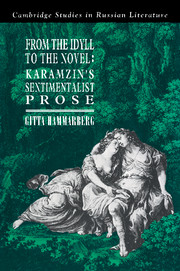Book contents
- Front Matter
- Contents
- Preface and acknowledgments
- Notes on the text
- 1 The literary and intellectual context
- 2 Theory of Sentimentalism
- 3 The literary model: the idyll
- 4 The extra-literary model: salon trifles
- 5 Serious Sentimental tales: narrator as narratee
- 6 Humorous Sentimental tales: narrator as parodist
- Notes
- Bibliography
- Index
3 - The literary model: the idyll
Published online by Cambridge University Press: 22 September 2009
- Front Matter
- Contents
- Preface and acknowledgments
- Notes on the text
- 1 The literary and intellectual context
- 2 Theory of Sentimentalism
- 3 The literary model: the idyll
- 4 The extra-literary model: salon trifles
- 5 Serious Sentimental tales: narrator as narratee
- 6 Humorous Sentimental tales: narrator as parodist
- Notes
- Bibliography
- Index
Summary
The middle echelon of the Neoclassicist genre–style hierarchy, and particularly the idyll, became increasingly important during the third and last, Kheraskovian, period of Neoclassicism. The idyll was also one of the genres that gained most attention among the Sentimentalists, and Karamzin's first venture into prose fiction was his 1783 translation of Salomon Gessner's idyll ‘Das hölzerne Bein’. The choice of the idyll genre was highly symptomatic of the era and can be seen as the common ground between the two literary movements and as the prime literary model for Sentimentalist prose. The emergence of a prose fiction that centers around the narrator can be elucidated to a significant degree by a closer look at the idyll as a literary form.
‘Poetry’ (‘Poeziia’) written in 1787, is one of Karamzin's earliest statements of literary credo. The pastoral poets are particularly prominently featured: Bion, Theocritus, Moschus, Virgil, James Thomson, and, in a section added later, the ‘Alpine Theocritus’, Salomon Gessner. Of sixteen named poets six are famed mainly for their pastoral poetry. Karamzin's omissions, as has long been noted by scholars, are equally characteristic, particularly the complete absence of French and Russian names, which can be interpreted as a rather blatant slap in the face of the Neoclassicist movement.
- Type
- Chapter
- Information
- From the Idyll to the NovelKaramzin's Sentimentalist Prose, pp. 44 - 92Publisher: Cambridge University PressPrint publication year: 1991



